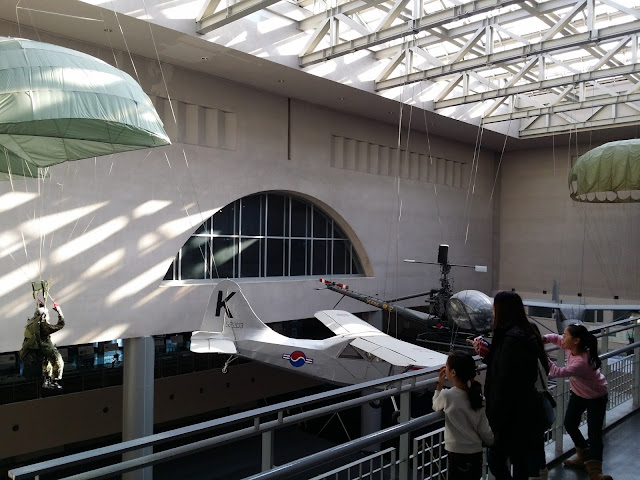Slow and easy was the name of the game as we recover in preparation for our trip to the ski resort. We decided on going out of Lotte complex to visit the War Memorial of Korea, highly recommended on Trip Advisor, and not too far away so that we could make it back by 4.30pm to meet up with friends for dinner.
 |
| Mummy strongly recommended buns from this bakery at Sadang subway station. This small bakery always sees long queues especially during the morning and evening peak hours. |
 |
| The original and cheese buns are apparently very popular here. Few things perk us up better than warm, freshly baked bread on a cold winter morning. Helps that these two buns were only 1000 won each. |
Child subway passes were no longer available for young foreigners, so we had to settle for single trip tickets instead, slowing us down a lot. When we alighted at Samgakji, we couldn't resist a warm breakfast of traditionally baked sweet potatoes and chestnuts. We took an elevator as we had a stroller with us but when we got to street level we were somewhat disorientated. It did not help that the locals also gave conflicting directions when we approached them. Despite the slight detractors we made it to the memorial and agreed to regroup two plus hours later. So the best way to get to the museum is from exit 12, and walk straight for 3 minutes and you would see the big museum compound on your left. Admission is free and is opened from 9am to 6pm. Closed on Monday and if the Monday is a public holiday, the museum will be closed the following day.
The next gallery was Korea's involvement in the Vietnam war. This gallery bore resemblance to the one we visited in Hanoi years back, but with a different perspective and less memorabilia.
The highlight were the interactive exhibits such as the shooting simulation and the F-15K Slam Eagle 3D experience. Although we made it on time for the earlier sessions, we were disappointed to find that the exhibits were not ready and we were told to wait half an hour later.
 |
| Trying out the K-2 rifle. |
On hindsight, it was incorrect for us to think we could browse the museum in a couple of hours. Leaving without the full experience did not do justice to the museum and its' exhibits. We strongly recommend an entire day there to appreciate the memorabilia and spirit of the men and women who laid down their lives so that others could live.
By the time we got back to the hotel, we had less than an hour before we headed out with friends. It was unfortunate that our little girl had a stomachache and Daddy stayed with her in the room while Mummy and the older girl went out for dinner.
 |
| Located just a short drive away from Lotte World Hotel, the restaurant is located on the second floor and was already crowded when we got to there. The restaurant is also called Gyeongbokgung, after Seoul's famous Gyeongbokgung Palace. |
 |
| Pumpkin soup and cold soup as starters. |
 |
| Sashimi as starters? |
 |
| Fried pumpkins and fried tofu with Korean chili paste. |
 |
| Octopus salad |
 |
| Finally, the star of the show. Korean's premier beef. Even without any marination, it was very tender and juicy. |
 |
| Tofu stew |
It was a very fulfilling meal. The side dishes kept coming and I wondered if I would even be able to stomach the main dish but when the trays of meat came, I was suddenly hungry again. The restaurant was apparently very popular as it was very crowded when we got there and even when we were leaving, it was still crowded. My friends planned to bring us for desserts after dinner but as my girl was already tired from the long day, my friends ordered takeaway instead.
 |
| Bingsu for desserts...in the cold. You can check out the various locations on their website, www.sulbing.com |
 |
| Friends ordered their traditional injeolmi rice cake bingsu, sprinkled with bean powder. They bought two and a traditional injeolmi rice cake toast and by the time we returned to the hotel, they were finished in a jiffy. The bingsu was not overwhelmingly sweet and the ice shavings were so fine that it melted in the mouth easily. Having tried the Korean bingsu cafes in Singapore, I dare say the ones in Korea are better. Maybe it is because we are having it in winter and they don't melt! |

























































No comments:
Post a Comment